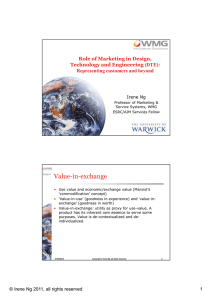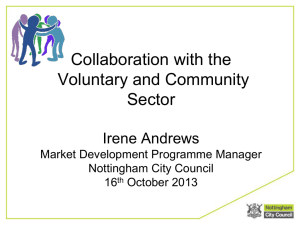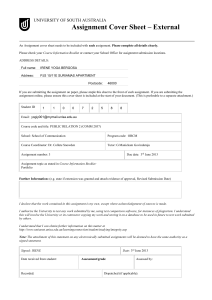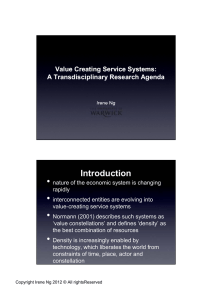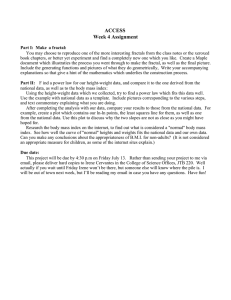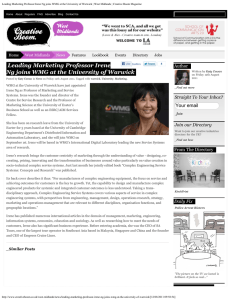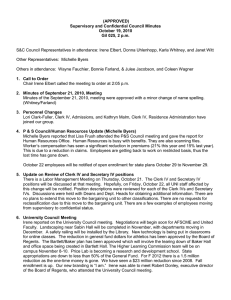The Shifting Boundaries of Marketing and Operations under Service-Dominant Logic 28/06/2012
advertisement
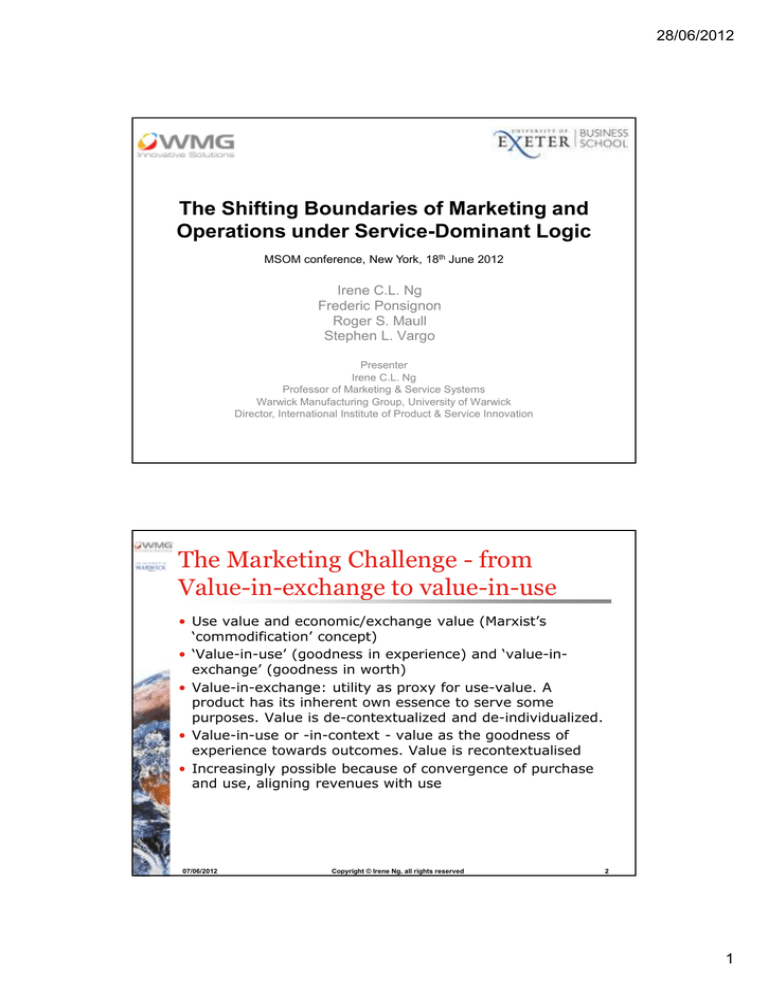
28/06/2012 The Shifting Boundaries of Marketing and Operations under Service-Dominant Logic MSOM conference, New York, 18th June 2012 Irene C.L. Ng Frederic Ponsignon Roger S. Maull Stephen L. Vargo Presenter Irene C.L. Ng Professor of Marketing & Service Systems Warwick Manufacturing Group, University of Warwick Director, International Institute of Product & Service Innovation The Marketing Challenge - from Value-in-exchange to value-in-use • Use value and economic/exchange value (Marxist’s ‘commodification’ concept) • ‘Value-in-use’ (goodness in experience) and ‘value-inexchange’ (goodness in worth) • Value-in-exchange: utility as proxy for use-value. A product has its inherent own essence to serve some purposes. Value is de-contextualized and de-individualized. • Value-in-use or -in-context - value as the goodness of experience towards outcomes. Value is recontextualised • Increasingly possible because of convergence of purchase and use, aligning revenues with use 07/06/2012 Copyright © Irene Ng, all rights reserved 2 1 28/06/2012 Context as the focus • because context is where value creation happens, we can now try to understand the way interactions happen and could change with different products and technology. • Technology liberates us from constraints of – – – – time, when things can be done place, where things can be done actor, who can do what constellation, with whom it can be done – (Normann, 2001) 06/07/12 Copyright © Irene Ng, all rights reserved 8 Context as the focus • context is where the market/revenues are • Convergence of context and choice e.g. outcome based contracts etc. 06/07/12 Copyright © Irene Ng, all rights reserved 9 2 28/06/2012 Context as the focus • we can focus on contextual invariances clusters of contexts that are similar. • when we focus on value in context, we need to shift our focus away from the individual, onto what Normann would call activity sets i.e. the context of the experience. • Instead of profiling individuals, we could be profiling contexts 06/07/12 Copyright © Irene Ng, all rights reserved 7 The traditional Marketing (M) –Operations (O) interface • Coordination and alignment of the M and O functions within and across companies • Strategic level – Impact of integrating M and O functions on firm performance – Aligning goals and objectives of M and O – Integration of multiple functional areas beyond M and O – Strategic role of supply chain management • Planning/Design level – Interrelationships product / process design; Service design – New Product Development – Demand management and capacity planning – Impact of pricing on demand/customer behavior – Marketing decisions, demand management, and production planning • Operational level – Customer experience management; Quality management 3 28/06/2012 The traditional marketing-operations interface • Interfaces for products – Issues are described before the product is used or consumed by the customer. – Very limited literature on interface issue arising from the consumption of products • Interface for services – Issues are more prominent because of the higher levels of customer intensity (i.e. co-production/consumption) • But@ – Is a services vs goods distinction needed when we shift the focus to context and outcomes? – The blurring of boundaries between operations and marketing seems applicable even when goods are involved From G-D Logic to S-D Logic • G-D logic (value-in-exchange) is the default logic in traditional literature – Scope of marketing: how transactions are managed or how the offering is developed, proposed, and sold to the customer – Operations: value is created in the manufacturing process and delivered when the product is transferred to the customer – IHIP to define and characterise “services” – The value of services is the reducible bundle of activities that is first exchanged and then delivered. →The interface between marketing and operations is that of effectiveness and efficiency of exchanges 4 28/06/2012 From G-D Logic to S-D Logic • Literature does not provide adequate frameworks or guidance on how traditional ‘products’ and ‘services’ work together as hybrid offerings to achieve outcomes • Little is known about how traditional interfaces might change when the firm’s offering is a hybrid or a part of a connected system of entities • Shift to S-D Logic (value-in-use) as a novel lens to analyze value-creating systems – FP1: Service is the fundamental basis of exchange – FP6: The customer is always a co-creator of value – FP9: All social and economic actors are resource integrators – FP10: Value is always uniquely and phenomenologically determined by the beneficiary • Business practice: markets are being created around outcomes of offerings, e.g. outcome-based contracts (OBC) of equipment-based service, outcomes of products that may be connected to other products. Value creation •GD Logic Value Propositions (provision of assets, time and information as exchange value) i.e. what we can sell you (and deliver) – focus on value in exchange and the buyer (choice & delivery) •SDLogic - Value Creating Activities (Collaborative co-creating activities to achieve value-in-use) i.e. what we do together (and with other entities) – focus on value-in-use and the context (use & delivery) 07/06/2012 Copyright © Irene Ng, all rights reserved 6 5 28/06/2012 Implications for the interface (1) 1. Unit of Analysis of operations management and marketing – Combined firm-customer value-creating service system, with entities rendering their competencies i.e. service, to achieve outcomes 2. Boundaries of OM and marketing – Shift towards the context of value-creating service system that privileges neither the material, user or technologies, but the service (competences) of the entities 3. Viability from Variety – Understand the dynamic configuration of resources contributed by both the firm and the customer that could absorb variety to achieve greater effectiveness in efficient and scalable ways Implications for the interface (2) 4. Segmentation – Marketing and OM to segment based on contexts of use and how outcomes are achieved within the contexts (major implications for operations design) 5. Managing the Value-Creating Service System – Processes and Practices; Functional and Emotional; Autonomy and Compliance 6. Modularization for new markets and new transactions – Collaboration is necessary for the possibility of new boundaries created for new offerings to enter and lend resources to the system, thus generating new markets 6
